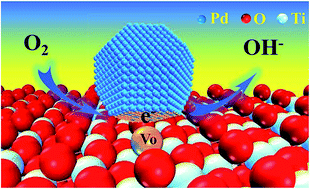当前位置:
X-MOL 学术
›
J. Mater. Chem. A
›
论文详情
Our official English website, www.x-mol.net, welcomes your
feedback! (Note: you will need to create a separate account there.)
Oxygen vacancies on TiO2 promoted the activity and stability of supported Pd nanoparticles for the oxygen reduction reaction†
Journal of Materials Chemistry A ( IF 10.7 ) Pub Date : 2017-12-29 00:00:00 , DOI: 10.1039/c7ta09831f Jing Li 1, 2, 3, 4, 5 , Hu Zhou 1, 2, 3, 4, 5 , Han Zhuo 1, 2, 3, 4, 5 , Zhongzhe Wei 1, 2, 3, 4, 5 , Guilin Zhuang 1, 2, 3, 4, 5 , Xing Zhong 1, 2, 3, 4, 5 , Shengwei Deng 1, 2, 3, 4, 5 , Xiaonian Li 1, 2, 3, 4, 5 , Jianguo Wang 1, 2, 3, 4, 5
Journal of Materials Chemistry A ( IF 10.7 ) Pub Date : 2017-12-29 00:00:00 , DOI: 10.1039/c7ta09831f Jing Li 1, 2, 3, 4, 5 , Hu Zhou 1, 2, 3, 4, 5 , Han Zhuo 1, 2, 3, 4, 5 , Zhongzhe Wei 1, 2, 3, 4, 5 , Guilin Zhuang 1, 2, 3, 4, 5 , Xing Zhong 1, 2, 3, 4, 5 , Shengwei Deng 1, 2, 3, 4, 5 , Xiaonian Li 1, 2, 3, 4, 5 , Jianguo Wang 1, 2, 3, 4, 5
Affiliation

|
The key bottleneck of applying Pd catalysts in fuel cells is their low activity and poor stability during the oxygen reduction reaction (ORR) although less precious Pd is still a promising alternative to Pt. Hence, new strategies to improve the performance of Pd in the ORR need to be developed. In this study, supported Pd (3.6 nm in average) catalysts on TiO2 with and without oxygen vacancies (VO) have been prepared via facile pyrolysis. Compared with commercial Pt/C (20 wt%) and Pd/TiO2 catalysts, Pd/TiO2-VO (10 wt%) demonstrated superior oxygen reduction activity, better durability, and higher methanol tolerance capability in alkaline solution. By means of experimental characterizations (ESR and XPS) and density functional theory (DFT) calculations, electron transfer from TiO2-VO to Pd nanoparticles (NPs) led to an electron-rich Pd surface and strong metal–support interactions (SMSIs). The electron-rich Pd NPs enhanced the adsorptions of key intermediates, lowered the Gibbs free energy of the ORR, and improved the ORR activity. SMSIs between Pd NPs and TiO2-VO endowed the catalyst with excellent stability and immunity to methanol poisoning. Therefore, the electron transfer from TiO2-VO to Pd NPs plays a crucial role in promoting the ORR performance of Pd-based electrocatalysts, which may be a new strategy to design high-performance ORR catalysts.
中文翻译:

TiO 2上的氧空位促进了负载的Pd纳米颗粒在氧还原反应中的活性和稳定性†
在燃料电池中使用Pd催化剂的关键瓶颈是它们的活性低和氧还原反应(ORR)期间的稳定性差,尽管稀有Pd仍然是Pt的有前途的替代品。因此,需要开发提高Pd在ORR中性能的新策略。在这项研究中,负载的Pd(平均3.6纳米)在TiO催化剂2有和没有氧空位(V ö)已经制备通过容易的热解。与商业的Pt / C(20重量%)和Pd /二氧化钛相比2种催化剂,将Pd /二氧化钛2 -V ö(10wt%)在碱性溶液中表现出优异的氧还原活性,更好的耐久性和更高的甲醇耐受能力。通过实验表征的装置(ESR和XPS)和密度泛函理论(DFT)计算,选自TiO电子转移2 -V ø到的Pd纳米颗粒(NP)导致了一个富电子的Pd表面和强金属-载体相互作用(SMSIs) 。富电子的Pd NPs增强了关键中间体的吸附,降低了ORR的吉布斯自由能,并提高了ORR活性。的Pd纳米颗粒和TiO之间SMSIs 2 -V ö赋有极好的稳定性和抗甲醇中毒的催化剂。因此,电子从TiO 2 -V O转移 Pd NPs的催化转化对于提高Pd基电催化剂的ORR性能起着至关重要的作用,这可能是设计高性能ORR催化剂的新策略。
更新日期:2017-12-29
中文翻译:

TiO 2上的氧空位促进了负载的Pd纳米颗粒在氧还原反应中的活性和稳定性†
在燃料电池中使用Pd催化剂的关键瓶颈是它们的活性低和氧还原反应(ORR)期间的稳定性差,尽管稀有Pd仍然是Pt的有前途的替代品。因此,需要开发提高Pd在ORR中性能的新策略。在这项研究中,负载的Pd(平均3.6纳米)在TiO催化剂2有和没有氧空位(V ö)已经制备通过容易的热解。与商业的Pt / C(20重量%)和Pd /二氧化钛相比2种催化剂,将Pd /二氧化钛2 -V ö(10wt%)在碱性溶液中表现出优异的氧还原活性,更好的耐久性和更高的甲醇耐受能力。通过实验表征的装置(ESR和XPS)和密度泛函理论(DFT)计算,选自TiO电子转移2 -V ø到的Pd纳米颗粒(NP)导致了一个富电子的Pd表面和强金属-载体相互作用(SMSIs) 。富电子的Pd NPs增强了关键中间体的吸附,降低了ORR的吉布斯自由能,并提高了ORR活性。的Pd纳米颗粒和TiO之间SMSIs 2 -V ö赋有极好的稳定性和抗甲醇中毒的催化剂。因此,电子从TiO 2 -V O转移 Pd NPs的催化转化对于提高Pd基电催化剂的ORR性能起着至关重要的作用,这可能是设计高性能ORR催化剂的新策略。









































 京公网安备 11010802027423号
京公网安备 11010802027423号